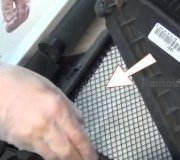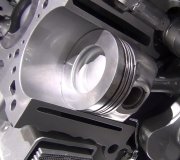Possible causes are as follows:
Fuel system malfunction.
EGR system malfunction.
Air intake or vacuum system leak.
Engine oil level too high.
Excessive internal engine wear.
Inspect engine for obvious defects in specified systems. Repair or replace as necessary
Vacuum leaks/unmetered air: In this type of condition, the engine may actually run lean of stoichiometry (14.7:1 air/fuel ratio) if the PCM is not able to compensate enough to correct for the condition. This condition is typically caused by air entering the engine through an abnormal source (opening), or due to a MAF malfunction. In this situation, the volume of air entering the engine is actually greater than what the MAF is indicating to the PCM. Vacuum leaks will normally be most apparent when high manifold vacuum is present, during idle or light throttle. If Freeze Frame Data indicates that the fault occurred at idle, a check for vacuum leaks/unmetered air when the engine is cold might be the best starting point.
Examples: Loose, leaking or disconnected vacuum lines, intake manifold gaskets or O-rings, throttle body gaskets, brake booster, air inlet tube, stuck/frozen/aftermarket PCV valve, unseated engine oil dipstick, MAF reading lower than normal, etc.
Insufficient fueling: In this type of condition, the engine may actually run lean of stoichiometry (14.7:1 air/fuel ratio) if the PCM is not able to compensate enough to correct for the condition. This condition is typically caused by a fuel delivery system concern that restricts or limits the amount of fuel being delivered to the engine. This condition will normally be most apparent when the engine is under a heavy load, when a higher volume of fuel is required. If Freeze Frame Data indicates that the fault occurred under a heavy load, a check of the fuel delivery system (checking fuel pressure with engine under a load) might be the best starting point.
Examples: Low fuel pressure (fuel pump, fuel filter, fuel leaks, restricted fuel supply lines), fuel injector concerns, etc.
Exhaust system leaks: In this type of condition, the engine may actually be running near stoichiometry (14.7:1 air/fuel ratio), but the exhaust gas mixture will be lean. This condition is caused by oxygen-rich air entering the exhaust system through an external source. This condition will cause the exhaust gas mixture to be lean, even though the actual combustion in the engine may not be.
Examples: Exhaust system leaks upstream or near HO2S, malfunctioning Secondary Air Injection system.
Wednesday, November 25th, 2009 AT 6:22 AM



